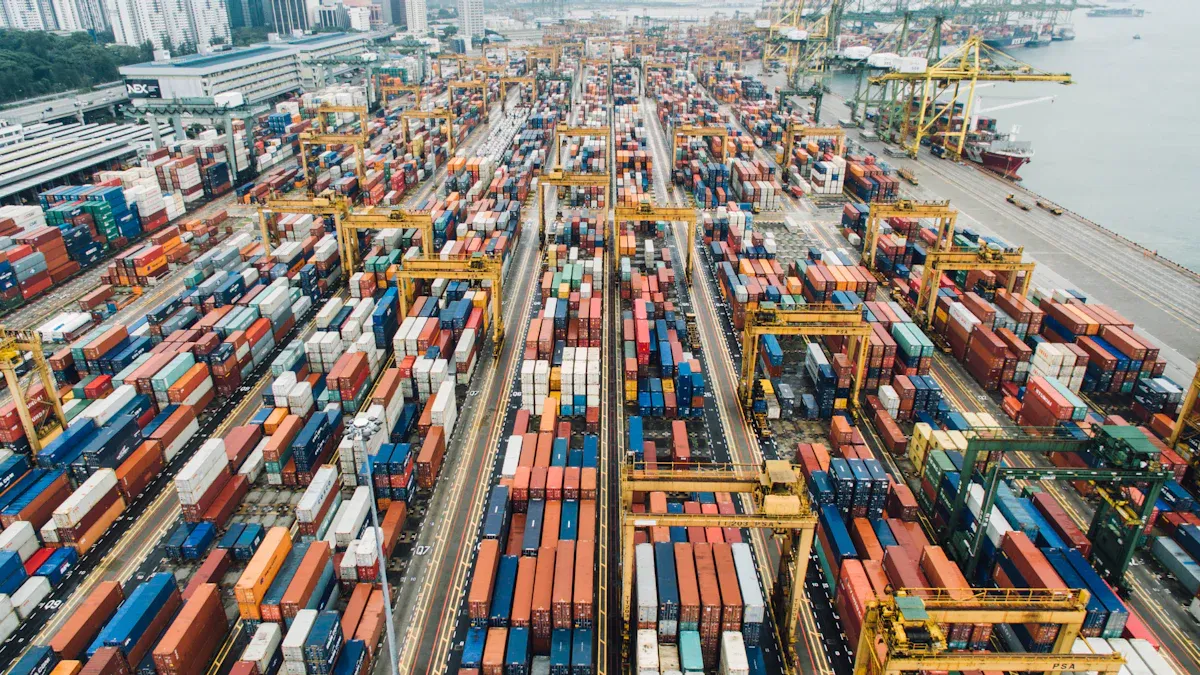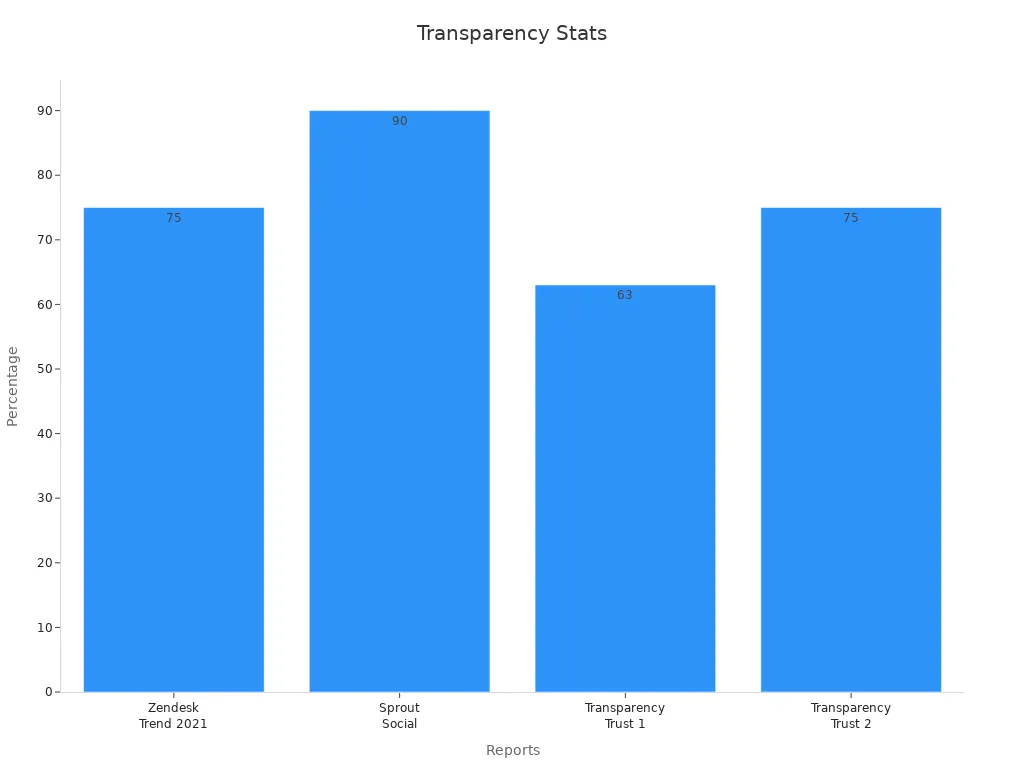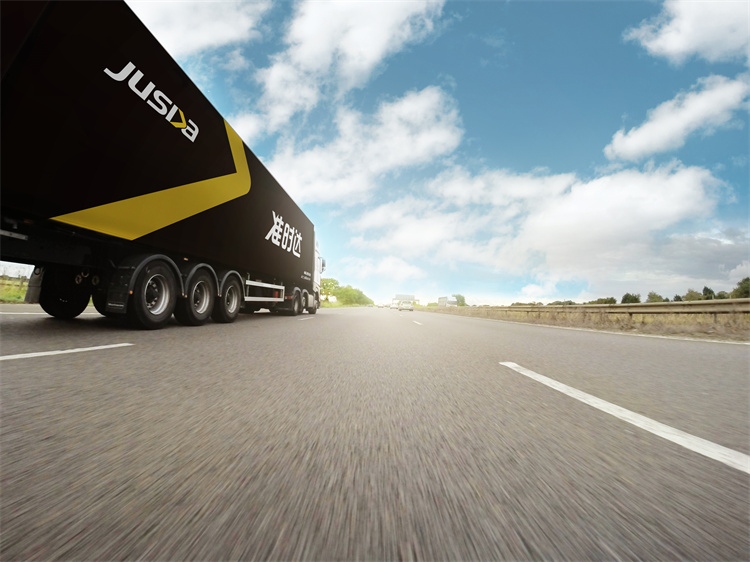10 Practical Tips to Enhance On-Time Delivery in Logistics

Timely delivery is crucial in logistics transportation time. It impacts customer trust and overall business success. Reducing delivery time by 5% can enhance supply chains by 12%, leading to improved customer experiences. Companies like Amazon demonstrate that quicker delivery increases customer satisfaction and strengthens their market power. Prioritizing on-time delivery ensures your business remains robust and trustworthy.
Key Takeaways
Use GPS and smart tools to plan better routes. This saves time, uses less fuel, and makes customers happy.
Use tracking tools to watch shipments in real-time. This helps control deliveries and shows customers you are honest.
Check and fix your vehicles often to avoid problems. Well-kept vehicles deliver on time and save money on repairs.
Plan Better Routes to Save Delivery Time
Use GPS and maps to make deliveries faster
GPS and maps are important for better logistics. They help track vehicles in real time and avoid delays. Live updates show where trucks are, helping fix problems quickly. For example, GPS can spot traffic jams or closed roads, keeping shipments on the quickest path.
Smart tools with AI study traffic and road rules. This helps pick the best routes, saving fuel and time. Real-time tracking also shows where goods are, giving more control. Alerts warn about problems, so you can solve them fast and stay on schedule.
Using GPS and maps makes routes better, saves money, and keeps customers happy. These tools are a must-have for today’s delivery systems.
Use smart route planning for quicker deliveries
Smart route planning uses live data to change routes fast. It saves fuel and cuts driving time, lowering costs for drivers. For example, checking truck loads ensures they carry as much as possible, saving time and money.
Companies like GLS Canada show how smart routing works. They use live data and AI tools to deliver packages faster and cheaper. These tools also save fuel and help drivers work better, making deliveries eco-friendly.
Smart route planning adjusts to weather or traffic changes. It makes deliveries faster and more reliable. Using this method saves time, boosts efficiency, and keeps your business ahead in logistics.
Use Real-Time Tracking to Deliver On Time
Get tracking tools to see deliveries clearly
Using tracking tools can change how you handle deliveries. Real-time tracking shows every step of the delivery process. You can check shipments, spot delays, and fix problems fast. This helps keep deliveries on time and improves how things run.
Studies show real-time tracking helps supply chains work better. Working well with partners makes tracking tools more useful. Good teamwork helps you get the most from your investment. Tracking tools not only improve delivery but also build customer trust.
Some industries saw a 60% boost in on-time deliveries with tracking. This tech helps you see problems early and solve them quickly. By using tracking tools, you gain more control and ensure deliveries are on time.
Share tracking info with customers to build trust
Being open is important for good customer relationships. Sharing tracking info lets customers see where their orders are. They feel less worried and have a better experience.
Facts show openness makes customers more loyal. For example:
75% of people spend more with companies that treat them well.
Almost 90% would forgive a bad experience if the company is honest.

Sharing tracking updates shows you care and are reliable. Customers like knowing when their orders will arrive. This makes them happier and improves your brand’s image. Being open with tracking builds trust and keeps customers coming back.
Make Fleet Management Better to Speed Up Deliveries
Check vehicles often to avoid problems
Taking care of your vehicles keeps deliveries on time. Regular checks stop surprise breakdowns that slow down shipments. Fixing small issues early helps vehicles run well and saves money.
Look at these key points about vehicle care:
Key Point | What It Means |
|---|---|
Breakdowns | Shows how often trucks stop working, delaying deliveries. |
Repair Costs | Tracks money spent to keep vehicles working. |
Time Off the Road | Measures how long trucks can't be used, lowering delivery ability. |
Paying attention to these points makes deliveries faster and smoother. Fixing vehicles early helps them last longer and keeps customers happy with on-time orders.
Use fleet tools to plan better routes
Fleet tools help make deliveries quicker and easier. They study traffic and past routes to find faster paths. This saves time and lets drivers deliver more packages each day.
Here’s how fleet tools help:
Example Feature | How It Helps Deliveries |
|---|---|
Smart routing adds more deliveries per day. | Speeds up work and cuts delivery times. |
Real-time updates improve decisions during deliveries. | Stops delays and boosts overall performance. |
These tools also help match trucks to delivery schedules. They let you watch how trucks are doing and fix problems fast. Using fleet tools makes deliveries faster and keeps your business ahead of others.
Improve Customer Communication for On-Time Deliveries
Share delivery updates to set clear expectations
Letting customers know about their orders builds trust. It also helps reduce worries. When you send updates on time, customers feel confident in your service. Share details like delivery status, delays, or changes to keep them informed. For example, send alerts when an order ships or is out for delivery. This way, customers know what to expect.
Telling customers about delays quickly lowers frustration. It shows you care about their time. This makes delivery experiences better and boosts your brand's image. Studies show customers stay loyal to businesses that share updates openly. By being honest, you can meet delivery promises and make customers happier.
Use different ways to communicate with customers
Giving customers many ways to contact you makes things easier. Some people like email updates, while others prefer texts or app alerts. Offering choices helps everyone stay updated about their orders.
Research shows why using many channels matters. For example:
Customer Preferences | What It Means |
|---|---|
Liking Multiple Channels | Most people like brands that use different ways to talk to them. |
More Likely to Buy | Customers buy more from brands that connect with them on many platforms. |
Combining these channels keeps information flowing smoothly. Customers can switch between them without confusion. Adjusting communication for different groups makes it even better. By knowing what customers want and giving them updates they like, you can improve deliveries and build loyalty.
Make Inventory Management Easier with JUSDA's Warehouse Tools
Use smart systems like JusLink for better stock control
Smart inventory systems, like JusLink, make managing stock simpler. These systems use modern technology to improve how things work. JusLink shares live updates, so all teams know stock levels. This teamwork lowers mistakes and makes everything run smoother.
Some helpful features include tools that predict future needs. These tools spot problems early and help you plan ahead. Automating tasks like packing saves time and reduces errors. Tracking products step-by-step keeps customers happy and meets rules.
Feature | How It Helps |
|---|---|
Predicting future needs | Helps plan stock levels faster and more accurately. |
Automating tasks | Cuts mistakes and speeds up packing and shipping. |
Sharing live updates | Keeps everyone informed for better teamwork. |
Spotting problems early | Finds issues before they slow down operations. |
Tracking products | Shows where items are, meeting customer and rule demands. |
Using tools like JusLink makes managing stock easier and faster. It helps avoid delays and keeps customers happy with on-time deliveries.
Keep stock levels correct to speed up deliveries
Having the right amount of stock is very important. Real-time tracking can cut delays by 15%, saving money. For example, delays can cost $10,000 daily. Fixing this could save $1,500 each day, adding up to big savings.
Good inventory management means having enough stock without overloading. This reduces waste and ensures items are ready when needed. Accurate stock levels make orders faster, improving customer happiness. Managing stock well avoids problems and keeps things running smoothly.
JUSDA's warehouse tools, like JusLink, help you balance stock levels. Features like live tracking and smart inventory tools give you control. These tools make deliveries quicker and keep customers satisfied.
Automate Key Processes to Make Deliveries Faster
Use automated scheduling to avoid mistakes
Automated scheduling makes delivery planning easier and faster. It stops human errors and keeps tasks running smoothly. Smart software uses live data to plan routes and assign resources. This helps avoid delays and makes deliveries quicker. For example, tools can focus on urgent orders to get them delivered on time.
Automation also helps with tracking drivers and checking their work. The software changes schedules based on traffic or weather problems. This makes deliveries more reliable and keeps everything moving well.
Here’s why automation is helpful:
Route planning becomes faster and more accurate.
Tracking drivers and their work gets easier.
Live data helps use resources better.
Using automated scheduling saves time, cuts costs, and makes customers happier.
Add robots to warehouses for faster deliveries
Robots make warehouse work quicker and more accurate. They handle jobs like picking, packing, and sorting items. This speeds up order processing by 70% and triples how much work a warehouse can do.
Robots also cut the time needed to prepare deliveries by 35%. They work with people to get more done and make deliveries faster. For example, robotic arms sort packages faster than humans, reducing delays and helping shipments arrive on time.
Task | Improvement Percentage |
|---|---|
Order Processing Speed | Up to 70% faster |
Warehouse Work Capacity | Up to 3x |
Delivery Prep Time | Cut by 35% |
Adding robots to warehouses makes deliveries faster and helps meet customer needs better.
Focus on Last-Mile Delivery to Improve Delivery Time

Work with local delivery services for quicker last-mile shipping
Partnering with local delivery services makes last-mile shipping faster. These services shorten the distance between warehouses and customers. They know the area well, so they avoid traffic and delays. This also saves fuel and uses resources better.
Teaming up with locals speeds up deliveries and builds trust.
Packages arrive faster, making customers happier.
Shorter routes mean fewer problems and better vehicle use.
Using local services helps manage busy areas more easily. This plan improves delivery speed and keeps customers satisfied. Quick and accurate deliveries leave a good impression and help your business stay strong.
Plan better urban routes for faster deliveries
Cities often have traffic jams and limited parking spots. Planning better routes in these areas is key to saving time. Smart tools check traffic, weather, and time of day to find the best paths. These tools give live updates to avoid delays.
FedEx uses live traffic data to change routes quickly. This cuts delays and makes deliveries smoother.
AI tools also help by picking the fastest routes in cities. Small vehicles like bikes or vans work better in crowded places. Flexible routing changes with conditions to keep deliveries on time.
By 2030, city delivery vehicles may increase by 36%, causing more traffic.
Smart routing boosts stops per trip by 30%, improving customer happiness.
Better urban routes make deliveries faster and smoother. This keeps customers pleased and helps your business grow.
Use Data to Make Deliveries On Time
Study delivery data to find problems
Looking at delivery data helps find what slows things down. Numbers like how fast and reliable deliveries are show where to improve. For example, tracking how often deliveries are late shows problem areas. Fixing these issues makes everything work better.
Using data can bring big changes. One company cut delays by 15% with smart tools. This also made customers happier. Experts say fixing problems can make work 30% faster. Another study found using advanced tools can improve work by 5 to 10% in a year. These changes make deliveries better and build customer trust.
By checking delivery data, you can spot problems and fix them. This keeps your supply chain running smoothly and improves delivery results.
Use smart tools to plan deliveries better
Smart tools help plan deliveries by looking at past data. They guess delays and suggest ways to avoid them. Big companies like Walmart and DHL use these tools to plan routes and manage stock. Walmart uses them to waste less and keep customers happy. DHL uses them to save time and use resources wisely.
Company | How They Use Smart Tools | Benefits |
|---|---|---|
Walmart | Predicting demand and managing inventory | Less waste, happier customers |
UPS | Planning delivery routes | Lower costs, better delivery times |
DHL | Predicting demand and planning routes | Faster deliveries, smarter resource use |
These tools also help use resources better. They make deliveries faster and cheaper. Using smart tools keeps your supply chain strong and helps you stay ahead of others.
Use Smart Technology to Improve Delivery Times
Let AI help plan deliveries and avoid problems
AI makes logistics better by solving problems early. It looks at data to guess demand, plan routes, and manage stock. For example, Amazon uses AI to know what customers want. They keep items in nearby warehouses to deliver faster. UPS uses AI in its ORION system to pick better routes. This saves fuel and cuts driving time, making deliveries cheaper and quicker.
AI also spots delays before they happen. It checks weather, traffic, and past data to suggest new routes or times. This helps deliveries run smoothly and keeps your supply chain strong. Companies using AI see better delivery results and happier customers.
Use IoT tools to track shipments live
IoT tools give live updates on where shipments are. GPS trackers and RFID tags show the location of goods. This helps reroute shipments or tell customers about delays. Sensors also check perishable items to make sure they stay fresh.
IoT does more than tracking. It helps control fleets, saving money and cutting empty miles. Real-time updates pick better routes and avoid traffic jams. Watching equipment stops breakdowns, keeping deliveries on time. These tools make logistics faster and more reliable.
Benefit | How It Helps |
|---|---|
Less Revenue Loss | Stops losing money from empty miles, saving millions. |
Better Fleet Control | Gives businesses more control over trucks and drivers. |
Smarter Routes | Picks faster paths and avoids traffic delays. |
Lower Costs | Saves money by protecting goods and avoiding spoilage. |
Using IoT tools makes deliveries more reliable and builds customer trust. These devices keep your logistics running smoothly and competitive.
Focus on Sustainability in Logistics Operations
Use green vehicles to protect the environment
Switching to green vehicles helps the planet stay cleaner. Regular fuel-based trucks pollute the air and harm health. Electric or hybrid vehicles use cleaner energy like electricity or bio-gas. These vehicles release fewer harmful gases than diesel ones.
Green vehicles also support renewable energy projects. Solar or wind-powered charging stations lower pollution even more. Using these vehicles shows you care about the environment. Customers like businesses that use eco-friendly methods. Choosing green logistics improves your brand and helps the Earth.
Make packaging better to cut waste and save resources
Better packaging reduces waste and makes deliveries faster. Using recyclable materials and smaller boxes saves space and protects items. Smart tools can pick the best packaging for each order. This helps trucks carry more items and use less fuel.
Switching to eco-friendly materials like paper bags has big results. For example, avoiding plastic has cut waste by over 41,600 metric tons since 2020. Lighter packaging also lowers delivery costs and speeds up shipping. These changes help the environment and make your business run better.
Metric | What It Shows |
|---|---|
Waste reduction | Tracks less waste from packaging and returned items. |
Better routes and truck use | Measures improved delivery efficiency and fewer empty miles. |
Customer happiness and brand trust | Shows how green practices improve customer loyalty and brand image. |

JUSDA Solutions
To provide you with professional solutions and quotations.
Delivering on time builds trust and improves how things work. Reliable deliveries help teamwork and keep customers loyal. Checking performance often helps businesses improve and stay ahead. Using these ideas can make your logistics better and show you are dependable.
See Also
Discover 5 Creative Approaches To Optimize Your Supply Chain
How Robotics In Logistics Boosts Warehouse Efficiency Significantly
Unlocking Logistics Savings: Essential Tips For Supply Chain Success
Essential Strategies For Effective Supply Chain Optimization Success
